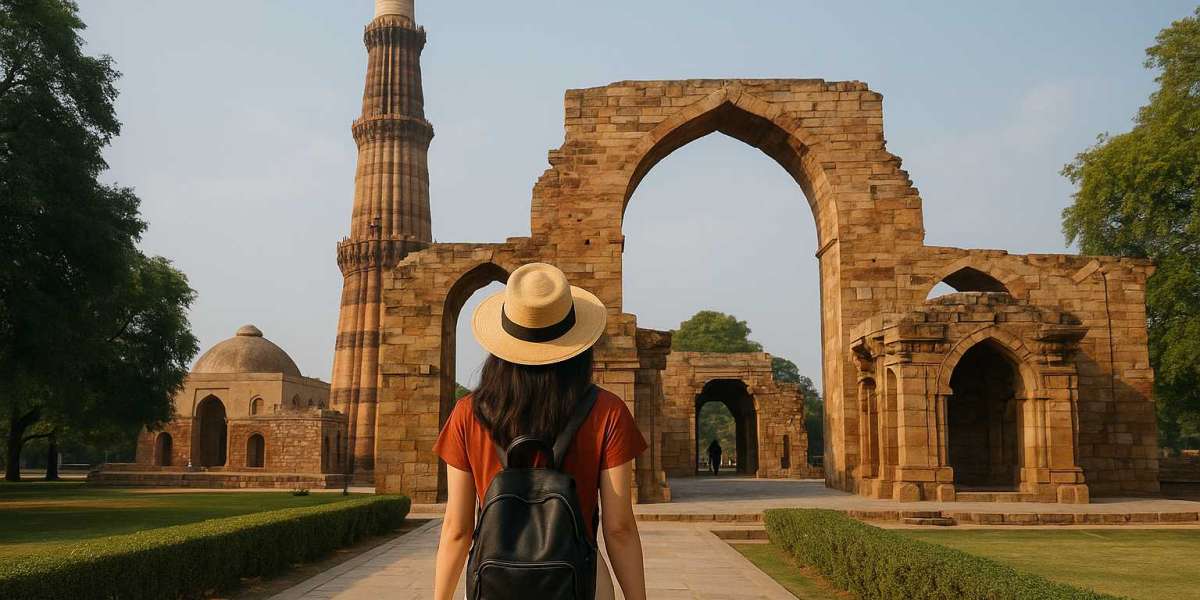India's capital, New Delhi, is a living tapestry of history, architecture, and culture. A city that has been the seat of powerful empires for centuries, Delhi is home to some of the most magnificent heritage sites in India. These sites offer glimpses into the grandeur of Mughal rulers, colonial legacy, and India’s rich past, making Delhi a top destination for history buffs, cultural explorers, and tourists from around the world.
Red Fort – A Symbol of Power and Resistance
Declared a UNESCO World Heritage Site, the Red Fort (Lal Qila) stands tall as a powerful symbol of India’s independence and architectural excellence. Built in 1639 by Mughal Emperor Shah Jahan, the fort served as the imperial residence for nearly 200 years.
Highlights:
- Massive red sandstone walls.
- Intricate marble inlays and floral motifs.
- Sound and light show in the evening.
- Independence Day flag hoisting venue.
? Timings: 9:30 AM to 4:30 PM
? Entry Fee: ₹35 (Indians), ₹500 (foreigners)
Qutub Minar – The Tallest Brick Minaret
Standing at 73 meters, the Qutub Minar is one of the oldest and most iconic monuments in India. Commissioned by Qutb-ud-din Aibak in 1193, this UNESCO site marks the beginning of Muslim rule in India and reflects Indo-Islamic architectural brilliance.
Must-See:
- The Iron Pillar of Delhi (resistant to rust).
- Quwwat-ul-Islam Mosque (first mosque in India).
- Beautiful Arabic calligraphy on the tower.
? Timings: Sunrise to Sunset
? Entry Fee: ₹35 (Indians), ₹550 (foreigners)
Humayun’s Tomb – A Precursor to the Taj Mahal
Built in 1570, Humayun's Tomb was the first garden-tomb on the Indian subcontinent. Commissioned by Empress Bega Begum, it’s a blend of Persian and Mughal architecture and a direct inspiration for the Taj Mahal in Agra.
What Makes it Special:
- Geometrically symmetrical gardens (Charbagh style).
- Resting place of several Mughal rulers.
- Peaceful ambiance and red sandstone beauty.
? Timings: 8:00 AM to 6:00 PM
? Entry Fee: ₹35 (Indians), ₹550 (foreigners)
India Gate – A Tribute to Fallen Heroes
Designed by Sir Edwin Lutyens, India Gate is not just a war memorial but also a central landmark of Delhi. It honors the 70,000 Indian soldiers who died during World War I and the Afghan Wars.
Best Time to Visit:
- Evenings, when the structure is beautifully lit.
- Take a walk along Rajpath or enjoy an ice cream near the lawns.
? Entry Fee: Free
? Timings: Open all day
Jama Masjid – India’s Largest Mosque
Jama Masjid, built by Shah Jahan in 1656, is among the largest mosques in India and a stunning example of Mughal architecture. It can hold up to 25,000 worshippers and offers panoramic views of Old Delhi.
Key Features:
- Red sandstone and white marble construction.
- Climb the minaret for a bird’s eye view.
- Shoes must be removed before entering.
? Timings: 7:00 AM to 12:00 PM 1:30 PM to 6:30 PM
? Entry Fee: Free (₹100–₹300 for photography/video)
Lotus Temple – The Temple of Unity
Though modern in comparison, the Lotus Temple is a heritage marvel in its own right. Shaped like a lotus flower, it serves as a Bahá’í House of Worship and is open to people of all faiths.
Unique Aspects:
- 27 white marble “petals” forming the lotus shape.
- Serene atmosphere with meditation spaces.
- No idols or religious icons inside.
? Timings: 9:00 AM to 5:00 PM (closed on Monday)
? Entry Fee: Free
Purana Qila – The Old Fort of Delhi
Purana Qila, or Old Fort, predates most Mughal architecture in the city. Believed to be built on the site of Indraprastha from the Mahabharata, it was reconstructed by Sher Shah Suri in the 16th century.
Why Visit?
- Ancient ramparts and serene boating lake.
- Light and sound show narrating Delhi’s history.
- Archaeological Museum inside the fort.
? Timings: 7:00 AM to 5:00 PM
? Entry Fee: ₹20 (Indians), ₹200 (foreigners)
Rashtrapati Bhavan – The Presidential Estate
Originally the Viceroy’s House, Rashtrapati Bhavan is now the official residence of the President of India. Spanning 320 acres, it features 340 rooms and majestic Mughal Gardens.
Visitor Experience:
- Book guided tours in advance.
- Visit Mughal Garden during spring (open for limited days).
- Marvel at Indo-European architectural fusion.
? Timings: Specific days/timings via online booking
? Entry Fee: ₹50–₹500 (depending on the type of tour)
Tughlaqabad Fort – The City of Ruins
Built by Ghiyas-ud-din Tughlaq in the 14th century, Tughlaqabad Fort stands as a hauntingly beautiful ruin. This massive structure was once a fortified city but was abandoned soon after due to a curse (as per legend).
Don’t Miss:
- Thick stone walls and massive battlements.
- Deserted, eerie charm ideal for photography.
- Nearby tomb of Ghiyas-ud-din Tughlaq.
? Timings: Sunrise to Sunset
? Entry Fee: ₹20 (Indians), ₹250 (foreigners)
Safdarjung Tomb – Mughal Grandeur in Decline
The last garden tomb of the Mughals, Safdarjung’s Tomb was built in 1754 for Nawab Safdarjung. Though less known, it’s a serene and picturesque spot in central Delhi.
Highlights:
- Mughal architecture with decorative marble.
- Peaceful gardens and fountains.
- Lesser crowd = better exploration.
? Timings: 7:00 AM to 5:00 PM
? Entry Fee: ₹15 (Indians), ₹200 (foreigners)
Agrasen Ki Baoli – Stepwell with a Story
Tucked away in the bustling streets of Connaught Place is Agrasen ki Baoli, an ancient stepwell dating back to the Mahabharata era. It’s one of the most photogenic spots in Delhi and has featured in several Bollywood films.
Experience:
- 103 steps leading into the ground.
- Haunted tales and historical charm.
- Great for Instagram-worthy shots.
? Timings: 7:00 AM to 6:00 PM
? Entry Fee: Free
Chandni Chowk – The Living Heritage
While not a monument, Chandni Chowk is a heritage walk in itself. Established by Jahanara Begum (Shah Jahan’s daughter), this bustling market area has stood the test of time since the 17th century.
What to Explore:
- Paranthe Wali Gali (for delicious street food).
- Kinari Bazaar (bridal and festive wear).
- Temples, mosques, and havelis co-existing in harmony.
? Best Time to Visit: Morning to late evening
? Entry Fee: Free
Tips for Visiting Delhi’s Heritage Sites
- Best Time to Visit Delhi: October to March (pleasant weather).
- Dress Modestly: Especially when visiting religious monuments.
- Carry ID: Many sites require photo ID for entry.
- Photography Charges: Always check signage for photography and videography rules.
- Hydration is Key: Carry water and sunscreen, especially in summer.
Conclusion: A Journey Through Time
Exploring Delhi’s heritage sites is like flipping through a living history book. Each fort, mosque, tomb, and alleyway tells a story of emperors, invasions, architecture, and endurance. Whether you’re a history lover or just want to witness the cultural richness of India’s capital, Delhi delivers a memorable experience.
So pack your bags, book your cheap flight from Dallas to Delhi with Indian Eagle, and get ready to explore the heritage wonders that make Delhi an unforgettable destination!


